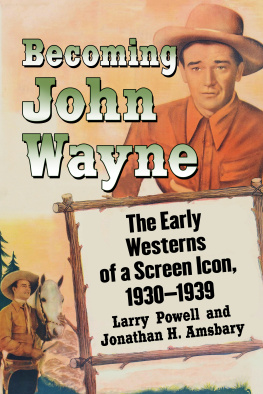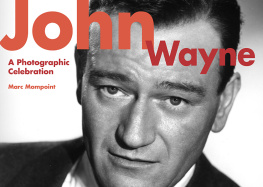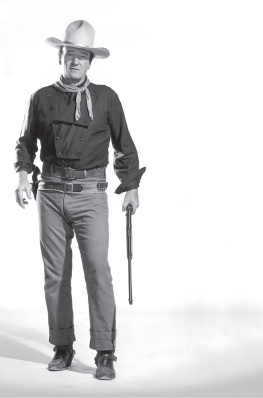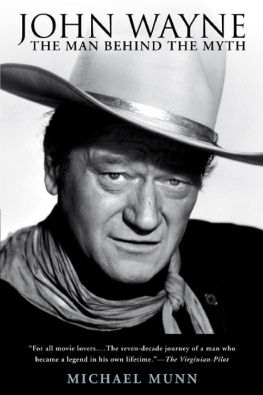
Becoming John Wayne
The Early Westerns of a Screen Icon, 19301939
LARRY POWELL and JONATHAN H. AMSBARY

McFarland & Company, Inc., Publishers
Jefferson, North Carolina
ALSO OF INTEREST AND FROM MCFARLAND: The Films of John G. Avildsen: Rocky, The Karate Kid and Other Underdogs by Larry Powell and Tom Garrett (2014); Black Barons of Birmingham: The Souths Greatest Negro League Team and Its Players by Larry Powell (2009)
LIBRARY OF CONGRESS CATALOGUING DATA ARE AVAILABLE
BRITISH LIBRARY CATALOGUING DATA ARE AVAILABLE
e-ISBN: 978-1-4766-2994-0
2018 Larry Powell and Jonathan H. Amsbary. All rights reserved
No part of this book may be reproduced or transmitted in any form or by any means, electronic or mechanical, including photocopying or recording, or by any information storage and retrieval system, without permission in writing from the publisher.
On the cover poster art from The Lawless Frontier, 1934 (Monogram Pictures/Photofest)
McFarland & Company, Inc., Publishers
Box 611, Jefferson, North Carolina 28640
www.mcfarlandpub.com
The authors would like to thank
Coleman McPherson
for his research assistance on this book.
His contributions are greatly appreciated.
Introduction
Becoming John Wayne explores the early Westerns of John Wayne, from his first starring role in the 1930 epic The Big Trail up to and including his breakthrough role as the Ringo Kid in John Fords 1939 classic Stagecoach. This book argues that it was during these 1930s Westerns that Marion Michael Morrison transformed from a prop man for the movie studios into the John Wayne film persona that became world-famous. He did that by using the decade to improve his acting skills, developing his ability to handle stunts, and becoming an expert horseman. Moreover, he became perhaps the most recognizable and iconic movie star of the studio age, if not all time. He also helped to transform the Western and action movies of the studio era.
The book provides plot summaries of these Westerns. Many fans have never seen these movies, and previous books about John Wayne have hurried through these productions. Most other books devote only a handful of pages to the movies themselves. In many books, most of these films are never mentioned at all. We have tried to correct those omissions.
After the box office failure of The Big Trail, Wayne was relegated to B Westerns where he honed his craft. He started the transformation by working in Westerns with Tim McCoy and Buck Jones, where his acting was often awkward and overstated, like that of a stage actor instead of a movie star. That was followed by a stint in a series of six Warner Brothers Westerns in which he shared billing with a horse named Duke; all six were remakes of earlier films by Ken Maynard. His acting started getting better, particularly in action scenes, but he was still awkward when working with his female leads.
Wayne then moved to Poverty Row, churning out Westerns for MonogramLone Star in which he developed an understanding of stunt work. His acting skills continued to improve, as did his stunt work. He and Yakima Canutt started developing the basic elements of on-screen fighting, in which one person would swing with a near-miss blow, while the other reacted as if they had been hit. Between his improving acting, stunt skills and horsemanship, Wayne became a cowboy hero in those B Westerns. His only setback was his brief, unsuccessful casting as a singing cowboy.
After a stint with Universal, he became a regular in Republics Three Mesquiteers series. By then, he was a full-fledged cowboy hero star, and his on-screen persona was well defined. His acting, riding and stunt skills were finely tuned. Not surprisingly, it was during this latter stint, he was picked by John Ford to play the Ringo Kid in Stagecoach. By the end of 1939, Marion Michael Morrison had completed the transition, becoming John Wayne both on and off the screen.
His early Westerns are largely forgotten by the viewing public, but they played a major role in developing his film persona. During those early films, he changed his name and worked on his acting skills. In the process, he quit being Marion Michael Morrison, or Duke Morrison as his friends called him, and gradually invented his new on-screen personality: John Wayne. In essence, it was during those early formative yearsfrom 1930 to 1939that John Wayne became John Wayne.
His son Ethan Wayne recalled that his fathers years of training went well beyond his acting skills. He described his father as a consummate professional who hones his craft and became not only the biggest Western actor, but also the best horseman and gun handler on the big screen.
His riding skills were apparent in a scene from the 1966 movie El Dorado. Facing the family of a man that he had just killed, Wayne backs his horse away from the ranch house, constantly keeping his eyes on the family that might want to shoot him. That maneuver took an expert horseman. Despite some critics who disparaged the way he sat on a horse, he had come a long way from the young actor who needed Yakima Canutt to double for him in nearly every riding scene.
Appropriately, his career started in Westerns. His first job was handling props for a Tom Mix Western. His first starring role was in a Western, Raoul Walshs The Big Trail. When that didnt work out, he turned to the Poverty Row studios and worked his way back to stardomagain by playing a cowboy hero.
Fred N. Cavinder noted that the link between Wayne and Westerns was an appropriate one: [I]t was, in retrospect, a moment of fate as inevitable as any showdown, as certain as the cleverest cutoff at the pass, as classic as the cattle drive. Wayne helped mold the Western movie and it, in turn, shaped him into a star.
If Westerns shaped John Wayne, he also helped to shape the Western. As Helen Akitt wrote, For many people, no one epitomizes the Western like John Wayne. With towering stature and steely gaze, Wayne dominated his movies like a national monument dominates the land. His image was a metaphor for America itself, its strength, its determination, and its reliability.
His name is now iconic, and he gladly accepted the new moniker. It seems like an easy decision now, butif anythingit could be criticized for being too common for a cowboy. That issue was discussed for humorous effect by Jackie Chan and Owen Wilson in the 2000 movie Shanghai Noon. When asked his name, Chans character replies, My name is Chon Wang. Wilsons character, misunderstanding the response, says, John Wayne. Thats a terrible cowboy name.
Still, by the end of the 30s, when Duke starred in Stagecoach, he had accepted the new name and developed the acting skills and persona that would make him a star. He then become famous. In most of those latter films, he simply played John Waynethe persona he spent ten years developing.
There were a few exceptions. He played two historical characters, rancher John Chisum in Chisum, his 1970 version of the Billy the Kid story, and Davy Crockett in Waynes own 1960 production The Alamo. In both cases, though, his interpretation of the characters were based on his longtime on-screen persona.
The only true exceptions were the two movies in which he portrayed Rooster Cogburn, True Grit
Next page








